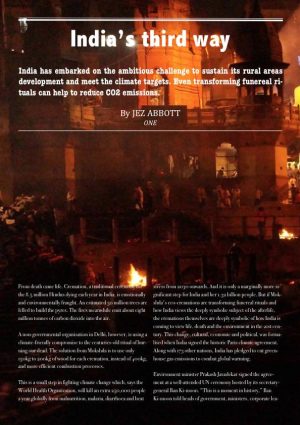 From death came life. Cremation, a traditional ceremony for the 8.5 million Hindus dying each year in India, is emotionally and environmentally fraught. An estimated 50 million trees are felled to build the pyres. The fires meanwhile emit about eight million tonnes of carbon dioxide into the air.
From death came life. Cremation, a traditional ceremony for the 8.5 million Hindus dying each year in India, is emotionally and environmentally fraught. An estimated 50 million trees are felled to build the pyres. The fires meanwhile emit about eight million tonnes of carbon dioxide into the air.
A non-governmental organisation in Delhi, however, is using a climate-friendly compromise to the centuries-old ritual of burning our dead. The solution from Mokshda is to use only 150kg to 200kg of wood for each cremation, instead of 400kg, and more efficient combustion processes.
This is a small step in fighting climate change which, says the World Health Organization, will kill an extra 250,000 people a year globally from malnutrition, malaria, diarrhoea and heat stress from 2030 onwards. And it is only a marginally more significant step for India and her 1.32 billion people. But if Mokshda’s eco-cremations are transforming funereal rituals and how India views the deeply symbolic subject of the afterlife, the cremations themselves are deeply symbolic of how India is coming to view life, death and the environment in the 21st century. This change, cultural, economic and political, was formalised when India signed the historic Paris climate agreement. Along with 173 other nations, India has pledged to cut greenhouse gas emissions to combat global warming.
Environment minister Prakash Javadekar signed the agreement at a well-attended UN ceremony hosted by its secretary-general Ban Ki-moon. “This is a moment in history,” Ban Ki-moon told heads of government, ministers, corporate leaders, and artists in the opulent UN assembly hall. “Today you are signing a new covenant with the future. We are in a race against time.”
But if Ban Ki-moon was carried away by the historic moment, Indian prime minister Narendra Modi takes a more pragmatic, cautious view. The burden of fighting climate change, he insists, cannot be lumped on the shoulders of developing or poorer nations such as India after decades of industrial development by their wealthy counterparts. And as a newly-elected PM four years ago Modi sidestepped a question on climate change during a Q&A session with school children, insisting it was not climate that had changed but rather our ability to deal with climate. If Modi wasn’t – and isn’t – in the camp of the climate-change deniers led by US president Donald Trump, he was – and remains – hardly a champion of the environment.
For India, energy is the life, death and resurrection of economic growth and social development. The bedrock of energy supply is, and always has been, its substantial reserves of coal. For this reason, the black mineral remains by far the largest part of the country’s energy mix – almost 60% of India’s primary energy comes from coal. Demand is therefore expected to climb despite the ramping up of renewable energy capacity implied by India signing up to the Paris agreement. Speaking to The Hindu newspaper, an influential former chairman of the world’s largest coal-producing company Coal India, Partha Bhattacharya, said if the future of coal was dark, then the future of the country was dark. “For all this hype about renewables, 81% of power generation is out of coal. The growth in renewables does not mean generation from coal will end. It will not come down, at least in the next few decades. It will go on increasing. For existing plants, coal-based generation is the cheapest and most affordable source of power in the country.”
And yet India has embarked on an ambitious journey to quadruple its renewable power capacity to 175 gigawatts by 2022 and supply electricity to every household. India seeks to add 100 gigawatts of photovoltaic capacity, 60 gigawatts of wind power, 10 gigawatts of biomass and five gigawatts of hydro projects. India insists it is completely committed to protecting the climate. But finance minister Arun Jaitley admitted recently at an industry conference “the hard reality is we have a lot of distance to cover.” India, which currently produces 650 million tonnes of coal and imports 150 million tonnes, still needs more housing, power, toilets, roads and factories. Fuel requirements will therefore certainly increase, and that means more fossil fuels like coal, gas, oil. The country’s coal minister Piyush Goyal agrees India’s top development priority is to provide affordable electricity to all. But because the availability of coal is abundant in India, it can provide that affordable power to propel growth plans and provide the goal needed to light every household. At best, according to analysts, renewable energy sources will coexist with coal for years to come. This is especially the case given that supplying energy to all four corners of India is such a huge challenge. The country, with a monster GDP of $2.3 trillion, is home to almost 240 million people with no access whatsoever to electricity. This is bad for overall development goals including poverty alleviation, health, food security and education.
A report on the India Climate Dialogue website told the story of Moyna. The schoolgirl has to study by light from a kerosene lamp or candles to finish her homework. Her village, Buraburi in the district of Goalpara in Assam, has no electricity. Despite being part of a rural electrification scheme, no work has been done to provide electricity to the 20 or so households. According to reports the parents and children protested. Such a move contradicts claims by Modi that electricity has reached each village in India and is not isolated. Nearby village Tengasot has about 120 households and electricity wires, but they connect only a few households with erratic power supplies. Meanwhile only half of the Mising community – listed as a scheduled tribe in the Indian constitution – based in Majuli, also in Assam, have power. Mounting public unease at home such as this, and wider global concern abroad, have prompted the traditionally firebrand Modi and his government take a more conciliatory approach and position India as a responsible player in the global environmental movement. India’s voracious need for energy, furthermore, comes in the shadow of several climate-change-related weather disasters. India has been wrung out by severe drought, meanwhile, an increasing number of lethal weather extremes such as thunderstorms, rain and strong winds have wiped out farms, businesses and homes in the states of Arunachal Pradesh, Assam, Manipur, Mizoram and Nagaland. Last summer more than 1,200 people died across India, Bangladesh and Nepal as monsoons blitzed 40 million people.
There is a third way. Even though coal is expected to continue to dominate India’s primary energy in the medium-term future, the country is exploring ways of using coal but reducing its greenhouse gas emissions. The government is pursuing measures to cut power-plant emissions by using cleaner, more efficient coal technologies and deploying complementary renewables, particularly solar. In recent years the Indian government has promoted plant efficiency in the country’s coal fleet, closing older low- or medium-capacity stations and building or upgrading the fleet to supercritical or ultra-supercritical high-efficiency, low-emissions (HELE) technologies. Coal plants could also be re-engineered to make them more climate friendly. A recent report from US Climate Policy Initiative think-tank suggests plants could be reconfigured to become “flexible”, so they could fill gaps in renewable energy production. After all, renewable energy’s biggest drawback is its intermittency. Wind turbines for example can generate only when the wind is blowing, while most solar technology can only fully function when the sun is shining. The idea of using coal plants for grid-balancing is not new and technically it can be done. For example, two plants at Moorburg, Germany, each with 800 megawatt capacities and mentioned in the think-tank’s report, have been converted to run as flexible plants that can operate under 40% of their capacity and still stay in business.
However, integration of large amounts of renewable energy into the grid calls for the creation of a source of power that can be switched on and off in quick time to fill in gaps in clean power generation. The CPI report calculates the technology required for this would cost more than the investments required to retrofit existing coal plants to make them flexible. Though India is the biggest recent signatory to the Paris agreement, it is merely part of a bigger picture. And all its efforts could be offset by the unstoppable economic momentum that sees businesses outsource work to the cheapest bidder. More industries in India are moving operations to less-developed Asian countries. This can only undermine not just India’s efforts to reduce climate-changing emissions, but the world’s.
Energy-intensive sectors, including manufacturing and raw materials processing, are relocating to cheaper countries like Indonesia, Vietnam and Thailand, a recent study by Britain’s University of East Anglia (UEA) showed. Shifts in production and trade will make it harder to meet the Paris agreement goal of cutting emissions enough to keep the rise in global average temperatures to “well below” two degrees Celsius above pre-industrial times. So says UEA professor of climate change economics and a co-author of the report Dabo Guan.
India, along with China, should help ensure power-efficient technologies and methods are adopted by industries that move off-shore to less-developed countries, he adds. For their part, shoppers in Europe and the USA must be educated to become more sustainable consumers, says Guan. Buying big on fashion or purchasing more than one car are consumer practices that must change. “We only have one planet, unless we move to Mars,” he told the Thomson Reuters Foundation. “If all the seven billion people in the world consumed like Americans, we would need seven or eight planets.”
According to Down to Earth, the magazine dedicated to the politics of the environment, development and health: “The Modi government’s performance when it comes to addressing climate change and the wider issues of environmental governance has been far from convincing. For optimists and supporters of the government, it could be called a mixed bag. For others, the words and actions of the government border on wily deception. Business is still the priority and all that has really changed during Modi’s four years are the words spoken in public. Where the PM used to deny climate change, he now invokes the Vedas (ancient religious texts originating in India) to find solutions – never mind that the scriptures are thousands of years old and share nearly nothing with modern realities.”
Jez Abbott





